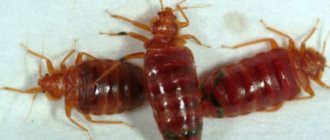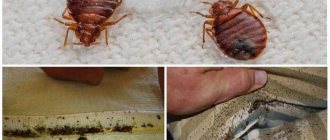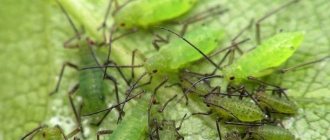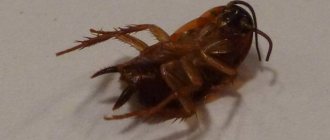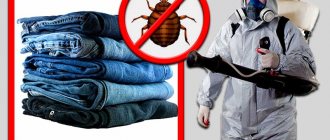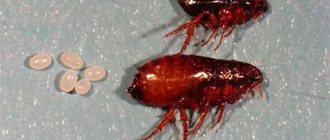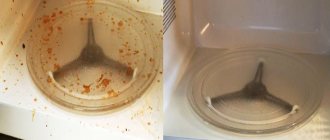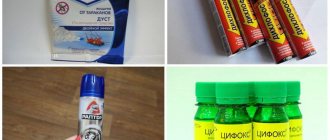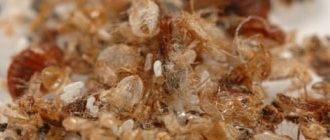Good day, dear readers! Today we will determine whether parasites can live under our pillows. Have you ever wondered if bedbugs live in your mattress? If yes, then this article is for you. Today we will discuss:
- How to determine the presence of a pest?
- How to fight the scourge?
- What to do to prevent the appearance of the parasite?
Why do bedbugs appear in bed?
Bedbugs always enter premises from somewhere outside, except when you move into an apartment where they have already lived before you. Insects can accidentally “arrive” in the house for:
- Your clothes and shoes
- Pet hair
- Packaging materials for goods
- Books and magazines
- Used purchases
- Furniture, including new
- Luggage and bags
If bedbugs live somewhere in the house - in the basement, in the attic, with neighbors, they can crawl into the apartment themselves through ventilation shafts, communication channels, cracks and open windows. The main reason why bedbugs appear in bed is purely practical - for parasites this is the most convenient place to feed.
At night, a person, practically without moving, spends a lot of time in bed, which gives bedbugs the opportunity to feed slowly and at the same time remain in relative safety, because the food literally comes to them and kindly freezes for several hours, even at that time of day, which is when pest activity peaks.
Why are furniture bugs dangerous? What diseases can be transmitted to humans?
If insects live in an apartment, a specific smell will soon appear - this is a sign of the presence of a large number of individuals. They leave behind excrement; when laying, females secrete a secretion that secures the eggs to surfaces. As a result, the intensity of the odor increases. At the same time, the sanitary condition of the home deteriorates.
Another danger when an apartment is infested with bedbugs is the increased risk of developing allergies in people who are attacked by pests. The body's reaction is always different. Sometimes the size of the red spots reaches 5 cm, while swelling is visible, the person experiences severe discomfort due to intolerable itching and painful sensations.
However, unlike other parasites, when they bite, these pests do not transfer pathogens to the victim. Dangerous microbes remain in the digestive tract of bedbugs. Theoretically, there is a risk of contracting hepatitis, typhus, tularemia or other diseases if you crush a bug on your hand immediately after it has become saturated. In this case, the condition must be met - the presence of damage to the human skin.
Where did bedbugs come from in the mattress?
The appearance of parasites in your bed can come as a complete surprise if you keep your apartment clean. So where do bedbugs come from and can they settle in a completely new mattress from the store?
In the photo: bedbugs in a mattress, old and new. Traces of their vital activity are visible; dark spots are bedbug excrement.
We list the main ways a bedbug can enter a house:
- ventilation system - through it insects move freely from one apartment to another;
- windows - in the warm season, bedbugs can move from the basement or neighboring apartment directly along the walls and enter your home through the window;
- guests - they can, without knowing it, bring parasites with them;
- hotels, hostels - by staying in unverified places on a trip, you risk bringing bedbugs home in a suitcase with clothes;
- workers - if they are doing repairs at your place, they may have brought bloodsuckers from the previous repair site;
- shops - from a furniture store you can bring new furniture or a mattress already infested with bedbugs into your apartment, because the warehouses in which goods are stored are not sparklingly clean.
Photos of mattress insects and their traces
Below we will present photos of parasitic insects that can live and breed in sleeping mattresses, and pay attention to what traces they leave around:
How to tell if there are bedbugs in a mattress
A bedbug cannot get inside bedding because its body is larger than the size of the pores in the fabric. A similar statement applies to parasite larvae. The only way for an individual to end up inside is if the tissue is damaged or if there are holes.
There is a common misconception among people that blood-sucking parasites live only in bedding, pillows, and blankets. This is due to the fact that larvae and adults prefer to go out in search of food at night. Waking up, a person sees red spots and realizes that he was attacked by bedbugs. Therefore, it seems that insects live only in beds and sofas. But sometimes they actually colonize the filling of pillows, blankets and other bedding.
How can you tell if there are bedbugs in a mattress? If you notice bites and red spots in the morning, start by visually inspecting the bed. The presence of bedbugs is indicated by dark spots on the sheets, mattress, or pillow. These are traces of crushed individuals and their excrement. At the seams there may be a light translucent husk - the remains of the chitinous shell. Another indirect sign is a sharp unpleasant odor, vaguely reminiscent of the aroma of fermented raspberries or cognac.
If the parasites have managed to seriously increase the population, then their larvae, live adult insects and clutches of eggs can be found on the back of the mattress and in the joints of the wooden elements of the bed. When treating a room, remember that nests of blood-sucking parasites should be looked for behind cabinets, under baseboards, in cracks in the flooring, behind the carpet.
Thus, the following signs indirectly indicate the presence of bedbugs in a mattress:
- marks on the skin from bites;
- dark spots on bedding and pillows;
- unpleasant and pungent odor;
- chitinous shells on the surface of a mattress, furniture.
It will not be possible to be 100% sure that bedbugs have settled inside the mattress based on visual signs. You can find out if you open the product and carefully turn out the filler. But if you suspect that there are bedbugs living inside your old mattress, it is better to get rid of it and buy a new one.
How to recognize parasites?
A mattress is simply an ideal habitat for insects - after all, it is a dark place where it is warm and there is a certain level of humidity. It is worth noting that the quality of the mattress plays an important role, and it is imperative to choose a durable and strong mattress. After all, domestic parasites can get through weak seams of a product, so reliable stitching is extremely important.
If there are parasites in your mattress, you will certainly notice some signs:
- Characteristic brown streaks appear on the material of the mattress or bed linen.
- When a person crushes insect larvae, a specific smell appears, which is quite noticeable.
- Small bites remain on the body, but they are accompanied by itching, which will immediately make itself felt.
- If a person unintentionally scratches the affected skin while sleeping in the morning, a person may notice red dots or spots.
We studied bed bugs from head to toe and compiled a list of recommendations for elimination.
How long do house bugs live?
The average lifespan of a bed bug is 10-12 months. In particularly extreme conditions (for example, during a sharp cold snap or the absence of a person in the house for a long time), they fall into suspended animation, in which they can remain for more than a year until the return of a source of food or normalization of external climatic conditions.
IMPORTANT! Household bugs are also called bed bugs, and their clutches instantly die at temperatures of +50°C and -10°C.
Lifestyle
Bed bugs are predominantly nocturnal. Only a certain danger or alarm can force them to become active during the daytime, for example, destruction of their habitat or the action of third-party chemicals.
The parasites are most active between 3 am and 6 am. At this time, they are especially dangerous for humans, since they go out in search of food, this is their feature. Insects are mobile and fast, they can get from any corner of the apartment to the bed in a matter of seconds, spend about half an hour feeding and return to their previous shelter.
Bed bugs spend most of their life cycle preferring to hide in various shelters, emerging at night to satisfy their hunger or to find a new home if the old one has been destroyed.
IMPORTANT! Parasites usually eat once every 5-7 days. If you notice new bites on your body every day, this is a sure signal that there are a huge number of parasites in the house.
After a single feeding, bedbugs digest the blood somewhere in a secluded corner of the home.
Reproduction and development
Bed bugs mate through traumatic insemination:
- The male, using his genital organ, pierces the female’s abdomen and injects seminal fluid into it.
- After a few weeks, the female begins to lay eggs (up to 5 eggs daily). Over the entire life cycle, one adult female is capable of laying about 250-500 eggs.
- An insect in an egg will develop to the adult stage on average 30-45 days, but in extreme conditions development can take up to 100 days.
- Bedbug larvae immediately begin to look for food on their own, because to move to the next stage of development (and to molt) they need a certain amount of blood they drink.
Life cycle of bedbugs
The lifespan of an adult insect is 12-14 months. The maturation period takes about 30-35 days, but if conditions for development are unfavorable, the larva goes into suspended animation.
During this period, life processes slow down, but as soon as conditions change for the better, the larva comes to life and goes through the entire life cycle starting from the interrupted stage.
The development process of a parasitic insect occurs in 3 stages. First, the fertilized female lays eggs. The egg then develops into a larva (nymph). After a short period of time, the larva becomes an imago (mature individual).
There is no intermediate transformation into a pupa, so entomologists classify bedbugs as insects with an incomplete cycle of transformation.
Life cycle of a bed bug.
Reproduction through violence
The method of reproduction of these insects can be called violent. The mating male uses a painful and quite traumatic method of insemination: he attacks the female, pierces her abdomen with the genital organ and injects sperm into the resulting hole.
The injected seminal fluid is enough for the female to reproduce offspring for the entire life cycle. She spends it gradually, as needed. In starvation conditions, the digested part of the seed can even become additional nutrition for the female.
Fertilization occurs through severe trauma to the female abdomen.
Males are promiscuous in sexual relations and can attack another male or a nymph incapable of fertilization.
A violent act can lead to its death, so nature has endowed the larva with the ability to secrete a repellent enzyme that causes a feeling of anxiety in the male.
Sexual intercourse with a male leads to mixing of seminal fluid in the body of the injured party.
As a result, during the next mating, the most viable sperm enter the female’s spermatheca.
Appearance of eggs and larvae
The egg develops in the female body for no more than 3-4 days, after which she lays it. The egg capsule resembles a translucent grain of rice, no more than 1 mm in length, making them difficult to detect.
At this stage of development, the bug is practically invulnerable: the shell of the egg is resistant to shock, temperature changes and does not allow pesticides to enter. Therefore, even after treatment, parasites may reappear in the house.
The larva that hatches from the egg is called a nymph. She looks like a mature individual, but is smaller in size. The color of the insect at this stage is almost transparent; you can even see the sucked blood in the abdominal cavity.
A bedbug can lay up to 5 eggs every day.
Larvae require a lot of nutrition to grow. At one time they consume less blood than adult arthropods, but feed more often.
Nymph bites are painful and immediately cause itching and burning, because... their saliva does not contain anesthetic. When a sexually mature bug bites, it injects a substance similar in effect to an anesthetic.
Whitish from birth, the larvae begin to change color due to molting. The chitinous shell does not stretch as the bug grows, so the insect sheds it every 5-6 days.
With each molt, the shell becomes darker in color. After the fifth molt, the nymph is ready to reproduce.
Adults
A sexually mature bug reaches a length of 4-6 mm. The color of its shell varies from red to almost black. The color depends on how much the sucked blood has been digested. The darker the color of the shell, the more blood was digested.
The insect's body is flat, which makes mechanical destruction difficult and makes it easier for the parasite to penetrate narrow crevices. When eating, the segmented abdomen stretches and swells as it fills with blood.
An adult bloodsucker has a pungent and unpleasant odor. Its odorous glands secrete a specific secretion, with the help of which insects scare off the enemy, communicate with each other and orient themselves.
How to find bedbugs in a mattress
Is it possible to independently detect blood-sucking parasites inside a product? How to find bedbugs in a mattress? This is a difficult and almost impossible task, since larvae and adults lead a nocturnal, secretive lifestyle. When a person appears, they immediately hide.
It is very difficult to detect a small bug, and even more so its larva, inside the filler. The presence of dark spots on the surface of the mattress and other indirect signs usually indicate the presence of blood-sucking parasites in other parts of the apartment - in the joints of upholstered furniture and wooden elements of the bed, in closets, in cracks in the flooring. A high probability of bedbugs entering the mattress occurs only if there are holes or other damage to the mattress cover.
Intelligence services
If you want to clean your mattress, bedding, and your entire apartment as much as possible from parasites, as well as prevent their occurrence in the future, you can contact a special insect extermination service. Specialists will carry out high-quality disinfection of mattresses, sofas, and all upholstered furniture. This method of disposal is especially suitable for cases where parasites have multiplied in too large numbers.
Thus, there are several methods to combat parasites in mattresses, but the easiest way is to prevent the appearance of insects in advance. Follow a few rules for handling a mattress - and parasites will not bother you, and your sleep will be truly healthy.
Bedbugs in a mattress, what to do
If a person finds out that he has bedbugs in his mattress, the first question that appears to him is: “What should I do?” Everyone will have a desire to get rid of unwanted neighbors as quickly as possible. The most effective method of exterminating blood-sucking parasites is to seek help from a professional pest control service. Qualified specialists, after a visual inspection of the premises, will develop an optimal strategy on how to get rid of bedbugs in a short time.
Today, two main methods are used to treat a room - hot and cold fog. They involve spraying a chemical using a special device - a generator, which supplies the insecticide in the form of tiny particles. They hover in the air and gradually settle on all surfaces of the apartment - walls, floors, ceilings, furniture and other interior items. This allows for the treatment of all hard-to-reach areas in a short period of time.
The hot and cold fog methods differ in the temperature of the chemical preparation. Preference is given to a heated insecticide if the room materials allow. But in most apartments and houses, treatment is carried out with a cold fog so as not to damage the wallpaper and furniture.
The chemical preparation has a great influence on the effectiveness of the event. Professional pest control services use a substance with a prolonged action, which has a detrimental effect on bedbugs for several more days. This allows you to destroy not only adult individuals, but also blood-sucking parasites that emerged from the egg after spraying the insecticide.
For maximum results and to prevent the reappearance of bedbugs, it is recommended to use comprehensive control methods, organize a protective barrier and carry out preventive measures. This may include the use of repellent aromas and preparations, the installation of a ventilation grill with small cells through which small insects cannot penetrate.
What to do after treatment?
- After treating the room, close windows, doors and vents, allowing the insecticides to sit and cover all surfaces in the room. Time limits for maintaining the premises:
- 3 hours when treated with cold fog or spray;
- 6 hours after hot fog and the use of a whole range of drugs.
- The next stage is airing the apartment, after which people can again lead a full life in it. The insecticide in the air will disappear through the window and ventilation, and the part that settles on the surfaces during the exposure of the room dries out and does not pose a danger.
- Clean the room, wash linens, curtains, clothes and soft toys. Wipe down floors, countertops and spray areas.
How and with what to treat a mattress against bedbugs?
First of all, you need to remove the bed linen from the mattress and wash it well at high temperature and steam or iron it.
The next step is to remove the mattress from the bed frame. To prevent the spread of parasites, carpets or other things located near the bed must be removed.
After the area is cleared, we begin to examine the mattress. We pull it out from the base, turn it over on its edge and examine it from all sides. Most likely, signs of bedbugs will be detected instantly. If they are not visible on the outside, look inside the mattress; perhaps this is where bedbugs live and breed.
If the covering is removable, then remove and wash it, then steam it thoroughly with a home steamer or hang it to dry in the sun. Treat the insides of the mattress with an insecticide against bedbugs; Xulat Micro or any other effective preparation is suitable for this. If the casing cannot be removed, begin processing immediately, but be sure to follow the manufacturer’s instructions and take safety precautions! Treat the entire area of the room, especially furniture located next to the bed, baseboards, corners and hard-to-reach places.
At the next stage, you need to disassemble the sleeping area and provide access to all hard-to-reach areas in order to destroy the parasites that have settled in them with a bedbug repellent. If the mattress is more than 5 years old, it would be better to throw it out and buy a new one, this way you will get rid of bed dust mites and allergies to them.
Where to look for bedbugs: TOP 10 places for parasites to hide
The main recommendation is a thorough inspection of things, objects, surfaces. Parasites have their own preferences when choosing habitats. To speed up the process of searching for insects, we determine the most popular areas among pests in the apartment:
- Mattress. Here insects are much closer to humans. You need to look for them by inspecting the seams, bedding, and the lower surface of the mattress.
- Bed frame.
- Sofa.
- Skirting boards.
- The back walls of furniture that is located next to the bed or sofa.
- Paintings (back side).
- Wall clock (mechanism).
- Internal surfaces of cabinets, bedside tables, armchairs.
- Sockets.
- The wrong side of the carpet.
How to treat a mattress to get rid of bedbugs?
We have already briefly described how to independently treat a room from bed bugs, now we will discuss what other ways there are to get rid of bed bugs in a mattress. There are four main ways:
- freezing;
- heat treatment;
- contacting a specialized company;
- self-removal of bedbugs using chemicals.
Let's consider the first method - cooling. In winter there is nothing complicated about it, since insects die from a temperature of -20C in about a day. Take your mattress out into the yard and leave it for two days. And when you bring it in, don’t forget to shake it off. This method is effective, but not 100%, since some of the bloodsuckers remain in the house, behind baseboards and in other secluded places.
Let's move on to the second method - exposure to hot air or steam. To do this, you need to thoroughly treat the mattress with a steamer or steam generator on all sides, without missing seams and joints. The method, like the previous one, has disadvantages.
You can seek help from a specialized company or city SES. They can be found in almost any city, all newspapers are full of such advertisements, and there are even more offers on the Internet. Do not be fooled by the low cost of the procedure; most likely, cheap treatment will be carried out with low-quality drugs that will not completely eliminate the problem. The average cost of services of a professional exterminator in Moscow is 2-3 thousand rubles.
Specialized chemicals, of which there are plenty on sale, will also help in getting rid of bloodsuckers. They differ in chemical composition and cost. It is better to buy new drugs rather than old ones that were used 10 years ago. Insects adapt to chemistry and become immune to it.
Modern insecticides have a complex composition and cost a lot - from 500 rubles. If there are children or pets in the house, be sure to take this into account when choosing a poison, choose a less toxic one, or take them away from the house during treatment.
There are also mechanical and manual methods of exterminating bedbugs, these are: crushing, destroying nests, sucking with a vacuum cleaner. These are very dubious methods that do not provide any guarantees.
Preventative measures to prevent insects from infesting the sofa
Any bugs can be kept out of your sofa if you follow the following preventative instructions:
- Regularly carry out wet cleaning with ventilation.
- Beetles do not like light, so you can always open the curtains during the daytime.
- In the sofa, let there be bunches of wormwood, lavender, sachets with caustic herbs, or other remedies for moths or skin beetles.
- It is better to have mosquito nets on the windows to prevent bugs from flying in if they are winged.
- Clean your shoes or pants when you come home from the street and vacuum and wash the hallway more often so as not to bring pests into the house.
- Less storage of junk in the sofa means fewer bugs.
- In a dry and warm “climate”, individuals develop very quickly.
The regular presence of blood-sucking insects in the bed means not only sleep disturbances, nightmares at night and itchy bites in the morning, but also a constant risk of contracting quite dangerous infections. Yes, such that the next day you can be busy all day just getting rid of such bites. For example, some blood-sucking human parasites are potentially capable of transmitting the causative agents of plague, encephalitis (and we are not just talking about ticks), anthrax and typhoid. This alone is enough for you to immediately take measures to remove them at the first suspicion of the presence of “bed” insects in the house.
You shouldn’t expect that living in a big city and a comfortable apartment will guarantee protection from insects in your bed. A characteristic feature of such human parasites is their indifference to the cleanliness and sanitary condition of the room, because they feed on blood, and not on the remains of our food.
Perhaps the most unpleasant blood-sucking insects that you can find in your bed are house bugs. It may seem strange, but they are a real disaster in Amsterdam, London and Stockholm. According to statistics, in most large European cities the number of apartments and houses infested with bedbugs is constantly growing, and disinfestation services cannot always cope with rapidly multiplying parasites that manage to develop resistance to the insecticides used. According to statistics, more than half of the homes in Florida, USA, have also been infested with bedbugs at some time.
When figuring out what insects bite you in bed, the easiest way will be to catch the parasite right at the scene of the crime, carefully examine it and compare it with the photographs below. Below are photos of the most common “bed” insects, in which you can recognize your offenders.
Bed bugs - their length, depending on age and degree of saturation, usually varies from 2-3 to 8 mm. The photo below shows this using an example of an adult bedbug:
This is what a bedbug larva looks like:
Fleas usually bite in the morning. They jump very well, and if you can’t catch an insect in the bed, perhaps it’s them.
The photo shows a flea on a human body at the time of the bite:
Linen lice are insects that are not even attached to the bed, but more to the human body. They bite around the clock, but at night their activity is especially noticeable.
Photo of an adult louse:
And this is what nits look like - lice eggs in a dense shell:
And, of course, mosquitoes - everyone knows them, so there will be no problems with their identification:
Some of these insects can be identified by the appearance of their bites, but the most reliable way to see the parasite itself is to see it in person.
Generally speaking, the insects that can be found on the sofa or in the bed include domestic cockroaches, but such cases are quite rare. Meanwhile, even ordinary red cockroaches, with a lack of water, can eat away the epithelium around the lips of sleeping people, especially children. This is exactly the case when we can say that even cockroaches bite.
So, if you have already managed to recognize which insects bite in bed, it’s time to get to know these parasites in detail to find out how you can fight them...
What to do with bedbugs found in bed
What to do if you find bedbugs in the bed and in other places in the room? They need to be destroyed. To do this, these places need to be treated with products that quickly kill bedbugs. These can be, firstly, insecticidal preparations based on organophosphorus compounds or neonicotinoids, or with a complex composition, which may also include pyrethroids.
On a note
It is better not to poison bedbugs with pyrethroids - they often develop resistance to these substances.
To treat the room yourself and prepare a working solution at home, you can take Get, Executioner, Lambda-Zone, Hector, Xulat, Tetrix - they are quite effective and resistance to them is extremely rare. They need to treat all the places where bedbugs are found, the entire bed and the entire mattress, all baseboards and those surfaces on which bedbugs move when they crawl from hiding places to your bed. Accordingly, you need to choose the appropriate amount - not only for the bed, but for the entire room.
The same Executioner, for example, according to customer reviews in online stores, you need to buy at least 5 bottles per room. If you take less, then there is often a need for re-processing.
Just when you buy a product, ask the seller how much you need to take for a specific area, taking into account the number of beds. The beds themselves with mattresses usually spend the same amount as the rest of the area.
Another way to deal with bedbugs is to warm the room to 50-55 degrees using a powerful fan heater, and maintain this temperature for 1-2 hours. Moreover, you need to remove the mattresses from the beds and place them against the wall. Furniture needs to be moved away from the walls. In this case, all the places where bedbugs hide will warm up to this temperature and the insects will die. We conducted an experiment and verified that at +50 degrees, bedbugs die in 10 minutes. That is, in an hour at this temperature in the room, all parasites will die.
Theoretically, it is possible to destroy bedbugs using a steam generator, but in practice it is not possible to get rid of them using a steam generator alone. Typically, a steam generator is used in addition to the application of insecticides. The steam is passed over the mattress, along the baseboards, and other places are treated with chemicals.
And it is important to treat the disassembled bed in this way so that the product reaches all the places where bedbugs can hide.
There is no need to treat the bed with anything. It is enough to wash it at the highest possible temperature so that those bugs that accidentally end up on it die.
How to clean a sofa yourself
A sofa is not only a cozy place in the house, but also the center of life. We relax on the sofa after a hard day, raise children, communicate with friends, arrange feasts, and our little brothers strive to sit comfortably on it. And after some time, the owners notice that the upholstery has lost color, become dirty, and in some places stains have appeared. The acute question arises of how to clean a sofa at home, and in such a way as to restore its original appearance to the maximum.
And in order not to be disappointed in the process of using and caring for the sofa, purchase a sofa that will meet the living conditions in your family. If you have small children or a cat or dog, which will often leave various marks on the upholstery, choose practical, non-light upholstery that will be easy to clean. Train all family members to cover the sofa with a blanket and, if possible, not eat on it, then maintenance care will not take much time and effort, and the appearance of the sofa will last much longer.
Which sofa is faster and easier to clean?
The most practical upholsteries that are quite easy to clean are matting and microflock. Plush, velor, velvet require more delicate use and special care. Heavy, expensive tapestry upholstery is very wear-resistant, but cleaning it is quite problematic.
All the recipes below for cleaning upholstery and removing stains using independent methods only work if you regularly maintain the cleanliness of your upholstered furniture and your home in general. Alas, dust accumulates not only on the surface, but also deep inside, in the filling of sofas. Therefore, at least once or twice a year it is necessary to resort to the services of professional dry cleaning.
Cleaning companies have special equipment that will powerfully pull out deeply ingrained dust. If you don't do this, then all your home cleanings will have the opposite effect. Even if you thoroughly vacuum the surface, the power of household vacuum cleaners is not enough to cope with internal dirt and, when you wet the upholstery, deep dirt will remain in the form of stains on the surface of the sofa. Simply put, you will be a mess, get frustrated, and waste valuable time. Therefore, be careful and follow logic when deciding to clean the sofa yourself.
How to clean a sofa yourself without ruining it
To avoid mistakes when cleaning fabric upholstery, first determine what type it is and whether it will shed or lose color if wetted with water and detergent. Be careful with fabrics such as plush, velvet and velor, they require delicate care. You should not wet the sofa too much, otherwise water will get inside, and after a while you will feel an unpleasant musty smell. The product you are going to use to clean the sofa should be tested on the most inconspicuous area.
Pile fabrics such as flock are best cleaned with a vacuum cleaner with a special attachment for upholstered furniture. For flock, choose a product that does not contain alcohol, and after cleaning, go over the entire surface with a soft brush so that the pile dries evenly and straightens.
It is not recommended to clean microfiber upholstery using the wet method at home; this work is for professionals and is done in exceptional cases. Microfiber is cleaned dry. When cleaning light-colored sofa upholstery, use only white rags, as colored fabric may fade when exposed to drugs, and you will ruin the sofa. You should absolutely not use bleach or undiluted vinegar when cleaning upholstery. If you are not sure about something, it is better not to attempt to clean the sofa yourself.
How to clean a fabric sofa at home
First you need to get rid of the dust. This is done either with a vacuum cleaner or with a damp sheet. If you vacuum, pay special attention to difficult areas of furniture, joints, and corners. Use a special crevice tool for hard-to-reach places. If there is no vacuum cleaner or the sofa is upholstered in velor, velvet or other pile fabric, then the dust needs to be knocked out. To do this, soak the sheet in soapy water and wring it out. Then cover the sofa and start beating over the entire surface.
You can do this procedure several times, but the sheet will have to be rinsed and wrung out each time. Thus, you will effectively collect dust from the sofa without polluting the air in the room. If the upholstery of your sofa is light, then the sheet can be soaked in a solution of 9% vinegar. The proportion is as follows: for 1 spoon of water, two spoons of vinegar. The rest follows the same principle. After such a wet procedure, you should dry the sofa before using it.
To clean the entire surface, you can make the following composition:
- Take a spoonful of detergent, a spoonful of baking soda and a spoonful of vinegar.
- Dilute all ingredients in a liter of water and foam.
- Apply foam with a brush in one direction to avoid streaks.
Make sure that there is not too much foam and the furniture does not get excessively wet. There are upholsteries on which a lot of foam forms, then wetting will be much more active. In this case, it is better not to use this method of cleaning the sofa upholstery.
There are upholsteries that do not allow the use of even a soft brush. In this case, there is another method for cleaning the upholstery. Take about half a glass of delicate laundry powder and mix with a glass of warm water. Then you create foam, apply it to the upholstery and wait for it to disappear. The procedure must be repeated up to 3 times, and then remove the dirty foam with a washing vacuum cleaner.
If there are solid contaminants, they need to be scraped off with a blunt object. It is impossible to scrape off solid dirt from fabrics such as velor, flock, chenille; they should be soaked with soap suds.
How to clean dirt from a sofa at home
There is another very common problem that occurs on the upholstery of upholstered furniture. These are greasy surfaces that look like shiny dark spots. Usually they are on the armrests, along the front edge of the seating space and on the back in the area of contact with the fabric of the back and head. Such stains arise from the combination of dust and soot particles with biological secretions of the human body. How to clean them from fabric upholstery?
For example, tapestry fabrics can be cleaned with a soap-soda solution or dishwashing detergent diluted in water. They dissolve fat perfectly and will not harm the fabric.
- Apply foam for 10 minutes;
- brush;
- rinse with clean water;
- blot with an absorbent cloth.
If necessary, repeat the procedure several times until the stains disappear. We recommend making the same solution to clean the entire surface of the sofa, only in a lower concentration, about 2 times. By cleaning the entire sofa, you will avoid unsightly moisture boundaries after cleaning the greasy area. It is important to let the sofa dry after this procedure and do not use a hairdryer, as uneven airflow will cause streaks to form.
It is better to clean stains on fluffy upholstery, such as flock, with a foam sponge. And as a product, use a solution of laundry soap, dishwashing detergent or “Vanish” for furniture.
How to clean a sofa from stains yourself
The next unpleasant problem is stains of various origins that stain the fabric or leave greasy marks. It is better to remove stains as soon as possible, before they eat deep into the fibers of the sofa upholstery. Keep paper towels or gauze on hand.
With these materials you can immediately blot the stain and most of the dirt will be absorbed into them, and not into the upholstery. What remains must be processed immediately. You need to work from the edges to the center of the stain so that the area of contamination does not increase.
The most common stains come from grease, fruit, chocolate, beer, wine and other drinks, blood, and urine. To remove stains, first try the universal method of removing with soapy water or Vanish. Apply the solution to the stain, leave for 15 minutes, then rinse with clean water and blot the moisture with a clean cloth. If this doesn't work, try the following formulations:
- 9% vinegar - 2 tbsp. for 1 liter of water.
- Add 10 drops of ammonia to shampoo with warm water.
Often these compounds help remove fresh stains from coffee, tea, chocolate, beer, jam, white wine, and Coca-Cola.
Grease stains can be removed with chalk, talc or salt. You need to sprinkle it on the contaminated area and leave it for a couple of hours. These substances perfectly absorb fat. Then they are removed with a vacuum cleaner or simply swept away. Beer stains are treated with a simple soap solution, and to remove the unpleasant odor, you need to additionally treat the area with vinegar.
Blood stains can be removed with cold water and soap, or if the stain is very fresh, sprinkle it with talcum powder. To remove stains from drinks, use ammonia. It must be applied to the stain and then rinsed with water. Remember that velvet and plush cannot be treated with soap solutions. Stains from these fabrics are removed with gasoline or alcohol.
If the stains are of a different origin or simple methods did not help. Here is a selection of recipes for removing stains of various types.
How to quickly clean a sofa with your own hands. Recipes
- The blood should be immediately washed with cold water, adding 1 aspirin tablet per glass or 1 tbsp per liter of water. spoon of salt. If the blood stain is old, then hold ice cubes on the stain, and then treat it with a weak solution of vinegar in a proportion of 2 tbsp. l. 9% vinegar per 1 liter. water. Then wash the stain with soapy water and finally with clean water.
- Traces of fatty food, plasticine or cream must first be removed with a spatula, and the stain should be covered with salt so that it absorbs the substances.
- If candle wax drips onto the upholstery of the sofa, let it harden. Then crumble and scrape with a spatula. Cover the wax stain with a thin cotton cloth or two or three paper napkins and run the iron several times. Can be repeated several times if necessary.
- Traces from a felt-tip pen, ballpoint pen, nail polish, lipstick are removed using ethyl/ammonia alcohol or acetone. And then the area is washed with clean water.
- Treat stains from fruits, vegetables or juices with a mixture of vinegar and ammonia in a 1:1 ratio, wait until dry, and rinse with water.
- Blot beer or coffee with a clean napkin, and then treat it with a soap solution with the addition of vinegar in a proportion of 2 tbsp. for 1 l. water.
- The red wine stain needs to be covered with salt so that it absorbs moisture. Then sweep away the salt with a soft-bristled brush and treat the stain with ethyl alcohol and then soap suds. Finally, remove any remaining soap with water and blot the area as much as possible with napkins or clean gauze.
- Jam, chocolate, condensed milk need to be dried a little so as not to smear on the surface. Then remove the dried crust and clean the stain with soapy water.
- Chewing gum should be frozen with an ice pack and then carefully removed with a knife. The chewing gum will come off quite easily, but if after this there is a mark left on the fabric, treat the area with methyl alcohol, and then rinse with water until clean.
- If the wooden armrests of your sofa are damaged, then there are solutions. You can get rid of stuck chewing gum using simple Vaseline. It needs to be rubbed into the chewing gum and after a while it will simply crumble. Vaseline will also help deal with white stains that remain from glasses of hot tea. Just rub Vaseline on these areas and after a few hours you will find that the stains have completely disappeared.
How to clean a sofa from urine stains at home
A separate topic is urine stains. This is the most unpleasant and complex organic contaminant, which not only leaves stains, but also has an unpleasant odor. You should immediately collect the urine with a napkin or rag. If the upholstery of your sofa is colored, then treat the stain with a solution of 9% vinegar in a ratio of 1:5 or a weak solution of potassium permanganate. If the upholstery of the sofa is light, then you can use a solution of citric acid in a ratio of 1:10, and after an hour, wash the area with soap and water and finally with clean water.
How to clean a sofa from odors yourself
To remove unpleasant odors from drinks, food or urine, you will have to work hard. You can, of course, use special products for furniture, but often this does not give a positive result. The liquid quickly seeps into the depths of the sofa filler, and the unpleasant odor will persist until you remove the cause from the inside. In this case, the compositions that you will use must be absorbed inside.
To remove the smell of beer or juice, you can use a vinegar solution in the proportion of 2 tablespoons per 1 liter of water (you can add a small amount of fabric softener). Soak a cloth in the solution and press firmly onto the damaged area so that the mixture penetrates into the upholstery. Repeat this procedure several times and then dry the sofa. The smell of vinegar will dissipate in a couple of days.
You can try to remove the smell of human urine from dark upholstery using iodine tincture. Dissolve 15-20 drops in a liter of water, soak the filler as deeply as possible. You can also clean the top of the upholstery with this mixture. If the sofa upholstery is light, then you can use diluted lemon juice in a proportion of 2-3 tbsp. l. for half a liter of water.
How to clean a sofa from the smell of cat urine
It is very difficult to remove the smell of cat urine. You will have to spend time and do it in several steps. First, wet the upholstery with a vinegar solution in a ratio of 1 part 9% vinegar and 3 parts water. Then the furniture should be dried. Then you need to sprinkle the surface with baking soda and spray with the following composition from a spray bottle: hydrogen peroxide and water in a 1:1 ratio. The composition is very foamy and should be left on the upholstery for 2-3 hours, and then remove the remaining foam with a damp cloth and dry. After complete drying, vacuum up the remaining soda.
But all this will have an effect if you immediately discover the cat’s trick. If the cat played a prank in your absence and the urine penetrated deeply into the litter, then you can, of course, try to combat the smell on your own, but it is unlikely to be effective.
You will have to heavily spill the upholstery with the compound or Vanish, and you will not be able to remove the liquid from the depths on your own. And in addition to the unpleasant smell of urine, you will also get the smell of musty litter. In this case, we recommend calling specialists who will use an extractor to extract the urine from the depths of the sofa and block the smell with effective, safe chemicals.
Clean your sofa at home
Special thick furniture covers will help extend the life of your furniture and protect it from contamination. Many people don’t like covers and bedspreads because they don’t cover the beautiful upholstery of the furniture. In this case, you can order a service such as hydrophobization from a cleaning company. A special composition is applied to the entire surface of the upholstery in several layers, and your sofa will be reliably protected from dirt, stains and moisture. This procedure is done on a slightly damp surface, so it is advisable to combine it with preliminary deep dry cleaning.
Remember that timely proper care significantly increases the service life and aesthetic appearance of upholstered furniture. This means that your nerves, time and family budget will be saved on the premature purchase of a new sofa.
https://bcleaning.ru
How to kill bedbugs in and around a mattress
There are several ways to remove bedbugs from a room. One of the most common is treating the apartment with special modern drugs that cause the death of parasites. This is the fastest, most effective and safest way. However, it is effective only when high-quality effective products are used, and safe if all rules for their use are followed.
We conducted several experiments and tested the effectiveness of such remedies as Hector, Get and Executioner. All of them poison parasites quite quickly. In particular, if the drug Executioner comes into direct contact with the body of a bug during spraying, it dies after 8 and a half minutes. Here is a video from the tests:
If a bug runs across a surface that has received the product, it dies after 19 hours. In one of the videos, we showed an experiment where we planted bedbugs in a container that had been sprayed with insecticide a week ago. The parasites died after 20 hours.
This information should be taken into account when processing an apartment. For example, if you find nests of bedbugs and poison them only in these places, they will die, but some of the insects that have taken refuge somewhere else will survive. For pest control to be effective, you need to follow several rules. Firstly, the entire room needs to be treated, including areas behind skirting boards, behind furniture, in cracks, and so on. It is also worth spraying the walls to a height of up to half a meter. Of course, the bed and mattress also need to be treated with the drug. Then you can put a clean mattress pad on the mattress and lay down a sheet. This will protect you from contact with the insecticide, but bedbugs that survive the treatment will crawl onto the treated surfaces and be poisoned. As a result, all parasites will die within a few days.
This is effective even in cases where the mattress is full of holes and bedbugs actually live in it. They will come out and come into contact with the insecticide, some of which remains on the fabric and other surfaces.
You can kill bedbugs in other ways. For example, you can warm up or, as people say, fry the room. To do this, place a powerful heater in the center of the room, with the help of which they raise the temperature to 50-55 degrees and keep it at this level for one to two hours. In one of the videos, we filmed an experiment during which we found out that at a temperature of 55 degrees, bedbugs die in just 10 minutes. Of course, a large cotton, wool, foam or bamboo mattress filled with coconut shavings, like any other orthopedic mattress, will not warm up so quickly. This may take an hour or more.
Sometimes they try to iron the mattress with an iron, but this is ineffective. It heats only the upper part, while the temperature inside does not rise to a dangerous limit for parasites.
Also, to kill bedbugs in the mattress, you can take it out into the cold. At temperatures below -20-15 degrees it will need to be left for 1-2 days. It is known that bedbugs die at a temperature of -17 degrees during the day, and even faster at lower temperatures. It is impossible to use this method to destroy parasites in an entire apartment. If you lower the temperature in it to this level, the pipes of the water supply and heating system will begin to burst.
If the mattress shell is intact, then there are definitely no bedbugs inside and it is enough to treat the outside. It can be sprayed with insecticide, paying special attention to the seams. This is where parasites often hide.
Our subscribers also talk about other ways to combat bedbugs. For example, some hid the mattress in an airtight cover with a lock, while others tightly wrapped it with cling film. As a result, the insects could not get out and died over time. These subscribers also said that they covered the legs of the bed and other adjacent surfaces with adhesive film. Because of this, insects that tried to get to the residents from their other escapes simply stuck to the adhesive tape. We have not tested how effective such methods are, but from a theoretical point of view and according to reviews, they can also work.
It should be borne in mind that there is no point in placing the mattress in a cover without covering the legs with adhesive tapes. The bedbugs that remain under the cover will die, but others will continue to bite you. In addition, they can quickly climb onto the cover and settle in its folds. During disinsection, specialists often find not only individual individuals, but also entire nests.
In some cases, if the mattress is very old, full of holes and infested with parasites, it is easier to throw it away and then buy a new one. There will definitely be no insects in the new one.
The same applies to blankets and pillows. If they are intact, then parasites cannot penetrate inside them. On the contrary, they climb into holes with holes with pleasure. Like a mattress, sometimes it is better not to treat them with anything, but simply replace them with new ones.
In general, if you have bedbugs in your home, you need to treat the entire room, not just the mattress and bed. They spread to all hidden places, and treating only some of these places has no effect. If you don’t know where bedbugs might be hiding in your house, call us and call our specialist for an examination - he will show you the parasites themselves and their nests.
Thermal methods
This category includes cold or heat treatment. It must be remembered that a certain temperature level is unfavorable for the life of parasites. In winter it is -20 degrees Celsius - this is the temperature at which insects die. Just expose the mattress to the cold if its size allows and the temperature outside is appropriate. As for heat treatment, parasites die at a temperature of +50 degrees Celsius. Thus, you can not only expose the mattress to the hot sun in summer, but also use a stream of hot air and boiling water.
Folk remedies that kill bedbugs
It is already known that such control methods are inferior in effectiveness to drugs. Folk remedies are used as an auxiliary measure, but they do an excellent job of killing bedbugs if they are used to fill the nests.
However
It will take a long time to remove the smell of the substance after this. This means that it is better to use such products carefully.
Using ammonia
It is recommended to treat the bed frame, then the parasites will try to hide from the unpleasant odor. If you apply this substance to textiles, the smell will remain on the fabric for a long time. Use a mixture of vinegar and ammonia.
The smell of ammonia disappears very poorly
Solution with naphthalene
If the question of how to remove bedbugs is being decided, they are expelled from the mattress using such a substance. Take 10 g of naphthalene. It is rarely used as a stand-alone measure. Naphthalene is mixed with denatured alcohol. The last of the components is taken in an amount of 150 ml.
Turpentine solution
You can use this substance in its pure form, but it is mixed with kerosene, the smell of which is not tolerated by parasites. You will need 100 ml of each component. They are mixed and the infected areas are treated.
Do not use near open fire!
Expert advice
Experts believe that the easiest way to get rid of parasites is with insecticidal agents. Only they will allow you to permanently remove bedbugs from the mattress
But you should take precautions and strictly follow the instructions for use.
- Dry wormwood should be placed in the mattress.
- During treatment with insecticides, doors and windows should not be opened; parasites should be given the opportunity to get enough of the poisons.
- Act together with your neighbors - the treatment should be carried out both at your place and at their place at the same time.
- Cleaning should not be done immediately. If necessary, you can wipe items that are used most often with water and baking soda.
- If there are a lot of parasites, re-treatment should be done after 14 days.
- Remove all items infested with larvae from the room.
Wormwood is an effective remedy for bedbugs.
Insecticides can be presented in various types - aerosols, concentrated or dry form. The latter must be diluted with water and used in a spray bottle for economical use. They will allow you to get rid of the problem in a short time.
"Karbofos" is the most effective drug
But you should work with it carefully. Be sure to use a respirator and gloves
The product is different:
- low price;
- long spectrum of action;
- the ability to use together with other fungicides;
- impressive spectrum of action - kills not only bedbugs.
Preparing the bed for processing
Before you begin processing, you should take the following precautions:
- remove pets from the apartment;
- use gloves, shoe covers, and a mask.
Personal protective equipment is necessary not only when using chemicals, but also to avoid the spread of bedbugs to other rooms. After processing, throw gloves and shoe covers into a street trash container, wash your face and hands with soap.
Step-by-step instructions on how to prepare a sleeping place for processing:
- Remove everything that can be removed from the bed and mattress: bed linen, covers, etc. Place in sealed plastic bags. It is very important to use sealed containers for transporting things around the apartment to avoid the spread of bedbugs throughout all rooms.
- Carefully shake out the items in the bathroom, then put them in the washing machine and wash them at a temperature not lower than +60 0C. Rinse the bathroom with boiling water.
- The mattress is placed horizontally against the wall and treated separately from the sleeping area. It should be carefully inspected for tears and damage. If any are found, the mattress is opened and processed not only outside, but also inside.
- The bed is moved away from the wall, the frame, if possible, is dismantled, and the elements are placed on the ends. If possible, the sofa or bed is turned upside down - this makes it easier to examine and process them.
- Use a vacuum cleaner to collect all the debris (which will probably include larvae and parasite excrement). The dust bag is thrown into a garbage container (under no circumstances should it be left in a vacuum cleaner). If the bag is reusable, or a container is used, then they must be treated with boiling water.
After the preparatory activities, they proceed directly to processing.
Dry cleaning of sofas from professionals
Without what furniture would a home not be cozy? Of course, without a soft and comfortable sofa on which you can lie down and read a book or watch TV, or just sit and chat with friends. It’s rare that a home has a sofa just for interior purposes; in most cases, it is a fairly popular place to spend time for all family members. Daily use leads to contamination of its upholstery, so the sofa needs to be cleaned regularly.
Cleaning a sofa at home is possible, but only in cases where the dirt is minor. For example, you can vacuum it or remove a simple stain with a wet cloth.
If the problem is more extensive: greasy upholstery, stubborn stains, persistent unpleasant odor, or you are afraid of ruining the color of the fabric, then it is better not to risk it and turn to professionals.
Specialists will be able to quickly and efficiently clean the sofa, regardless of the degree of soiling. In their work, they use special cleaning products that will not only remove any stain, but also will not affect the color of the fabric.
Mattress and bed treatment
They use chemicals, high and low temperatures, and folk remedies. You can call professionals from the SES (Sanitary and Epidemiological Station).
SES will carry out professional pest control and provide a guarantee for its services (usually three months). The negative point is the high cost of the procedure, which is carried out with professional means, a hot or cold fog generator.
Chemicals for self-treatment:
- aerosols,
- crayons,
- gels,
- dry powders.
Depending on the type of effect, chemotherapy drugs are:
- imagocidal - for the destruction of adult individuals;
- larvicidal – have an effect on larvae;
- ovicidal - destroys egg-laying insects.
Advice! Treatment with any poison is carried out more than once with an interval of one to two weeks in order to destroy not only adults, but also larvae.
Sprays and aerosols are sprayed around the perimeter of the bed, paying special attention to the joints of the frame. The mattress is sprayed along the seams, from the ends and, if necessary, over the entire surface. After treatment, the mattress is sent to dry cleaning.
Attention! Sprays and aerosols may leave stains.
When using highly toxic drugs, it is not recommended to spend the night in an apartment for a period of two days or more. The products are not used for treating clothing and bedding.
Silica gel can be used as a remedy for bedbugs if there are no animals or small children in the house
You can use silica gel or diatomaceous earth powder. Sprinkle along the baseboards and around the bed. The substance sticks to the insects and they die from dehydration.
Attention! It is not recommended to use the product if there are children and pets in the house.
High temperature is created:
- steam generator,
- steam cleaner,
- boiling water,
- iron,
- washing and drying machines,
- construction hairdryer,
- thermal gun.
The mattress is treated with steam, furniture - with steam or boiling water. Use an iron, steam generator or steam cleaner to treat all seams and surfaces of the mattress, blanket, and pillows. Pillowcases, sheets, duvet covers are washed and dried at maximum temperature.
When the room is heated with dry heat to a temperature of at least 50 0C, bedbugs and eggs die within 6-8 hours. You can achieve this temperature yourself using a heat gun (equipment can be rented).
Safety rules for high temperature processing:
- Do not point the steam generator at electrical appliances and electrical sockets, wallpaper, wooden, varnished surfaces and other materials that are unstable to heat and humidity. Set the minimum humidity in the device settings.
- Wrap the steam cleaner nozzle with a cloth to prevent insects, their larvae and eggs from being blown away.
- Wardrobe items that cannot be treated with high temperatures should be dry cleaned.
Low temperature:
- freezer,
- sprays and cans.
In winter, things are taken out into the yard or onto the balcony for at least two days. It is not recommended to freeze the entire apartment, as heating pipes may burst and wallpaper may become unusable.
Note! The outside temperature should not be higher than -22 0C.
Pillows and bed linen are packed in bags and left in the freezer for a week at a minimum temperature.
Important! A positive result is achieved provided that all places where bedbugs accumulate have been detected and treated.
It is more difficult to treat a sofa and an orthopedic mattress due to the fabric covering and the presence of a large number of rough edges and pockets. The sofa is treated in the same ways as the mattress (insecticides, steam, freezing). After treatment, the surface where it will stand is treated with chemicals. The legs are covered with adhesive tape and traps are set.
An orthopedic mattress is an expensive thing, so replacing it is problematic. The destruction of parasites that have settled in it is carried out similarly to the treatment of a regular mattress.
If insects are found, it is recommended to treat the entire apartment. In multi-storey buildings, bullying should be carried out in the entire entrance, calling the special service of the management company. Before treating the premises, personal hygiene products and dishes are wrapped in cling film and packaged in plastic bags. All clothes, bed linen, towels, soft toys are washed, ironed, dried and put into plastic bags. The electronics are covered with polyethylene.
At the end of the treatment, dead parasites and traces of their vital activity are collected with a vacuum cleaner, the apartment is ventilated, the dust bag is thrown away or doused with boiling water. Dishes and personal hygiene products, floors and furniture surfaces are washed. The apartment is ventilated for an hour.
Features of parasitism and reproduction
Reproduction of a bed bug In comparison with house flies, the female of which lays up to 400 eggs in 4 days, the reproduction of bed bugs does not occur at such a rapid pace, but the size of the colony increases exponentially. Over the course of its entire life, a female lays no more than 500 eggs. She does this in doses: 5 pieces daily. According to observations, the female tries to hide the oviposition every time. Such foresight contributes to the safety of the population.
With good vision, bedbug eggs are clearly visible. Their size is slightly less than a millimeter and they are oblong white capsules resembling grains of rice. Within a week, larvae (nymphs) emerge from the eggs; they are distinguished from adults only by their size. As they grow, nymphs molt, and their chitinous shells can often be found on a mattress, floor, or bed. A month after hatching from the egg, the larva becomes a sexually mature individual, ready to reproduce. The ratio of both sexes in the colony is the same, so there are no difficulties with mating.
Bedbugs enter the apartment through cracks from neighbors, get into purchased antique furniture, in luggage, on clothes after spending the night in hotels or other infested objects.
Safety precautions for chemical processing
It is recommended to carry out any work with insecticides with protective gloves. If you have to use liquid substances or aerosols, it is necessary to protect the outer coverings by wearing closed clothing. In addition, a respirator and safety glasses are used. Clothes will have to be washed after treatment, or better yet, thrown away.
Some surfaces
on which the drug is applied are subsequently partially cleaned, since they have to be used in everyday life. General cleaning is carried out after 1-2 weeks.
Do cockroaches bite at night?
Cockroaches rarely bite humans. They are inhabitants of kitchens, feeding on crumbs from the table and leftover food in trash cans. Only with very abundant reproduction and a lack of water can they crawl onto the bed and gnaw the epidermis around the lips and nose of people. Today, similar situations sometimes occur in hostels.
Of course, cockroaches are not blood-sucking insects, so even if they bite, it’s completely different from the way fleas or bed bugs do.
In any case, if you are bitten by insects, their bites should be treated to reduce itching and prevent infection:
- bite sites are washed with soapy water
- the most painful bites are wiped with alcohol or alcohol tincture of calendula or propolis
- Itching from bites can be reduced with Fenistil gel.
But if, after being bitten by blood-sucking insects, the temperature begins to rise and a characteristic rash appears on the skin, it is advisable to show the person to a doctor. An allergy to bites can have serious consequences, and even if at a particular moment it does not manifest itself very strongly, in the future the reaction to bites can be extremely acute.
The most modern, stylish apartment is not protected from insects. Small crawling, flying individuals do not pay attention to the degree of grooming or the design of the home. Penetrating in different ways, they can cause a lot of problems for the owner, especially if they choose a sofa as their habitat. In this article, we suggest finding out what can grow in upholstered furniture, and we will also tell you about the ways that insects can enter the apartment.
Prevention
There is no 100% protection against bedbugs in your home. Maintaining cleanliness and order in the apartment will help to detect their appearance in a timely manner and avoid further spread.
Prevention measures:
- Washing bed linen at maximum temperature followed by ironing.
- At least twice a year, the mattress is turned over and inspected. If a trail of feces or remains of chitinous shells is detected, they immediately begin to bait the bedbugs.
- Upon returning from vacation, travel bags are checked for parasites. As a preventive measure, suitcases are treated with steam.
- Periodically check and install new sockets.
- Cracks and crevices are sealed with sealant.
- They are making cosmetic repairs to the apartment - gluing up wallpaper and baseboards.
- Periodically inspect chairs, sofas, and cabinets for the presence of bedbugs.
Advice! When inspecting, use a flashlight and a magnifying glass.
- Parasites love to settle under parquet floors, and it is almost impossible to get them out of there. Therefore, do not use this material as a floor covering.
- Used items and furniture should be washed, ironed, steamed, and dry-cleaned.
- If there are a large number of books, they are periodically inspected.
- Check the back and back walls of the bedside tables, having first removed all things from them.
- When staying at a hotel, they check the mattress and bed. If there is any doubt about the presence of parasites, personal items are packed in sealed bags.
- When returning from guests who have bedbugs, wash bags and clothes and wash shoes.
- Purchase a special removable sealed cover for the mattress, which will prevent the spread of parasites.
- Before moving into a new apartment, carry out pest control.
- Use bait and traps. For example, wrap the legs of a bed with duct tape and place traps on four sides.
Barrier protective treatment is an effective way to limit the entry of parasites from other apartments. Invisible fat capsules are applied throughout the room using a fog generator or manual irrigation. Upon contact with an insect, the substance covers its chitinous shell, preventing further reproduction.
Preventive measures
It is not possible to completely protect your home from pests. But there are options that help worsen their living conditions and reduce the likelihood of their reproduction. The main principle of protection can be the choice of special sockets and timely cosmetic repairs. Here is another list of actions:
- Turn the mattress over frequently and check it for any signs of insects.
- Try not to bring old things into the house or carefully inspect them.
- Wear shoe covers in places where bedbugs are likely to spread.
- Don't take other people's furniture off the street.
- Inspect the wallpaper on the walls; there should be no defects on them. In the future, bloodsuckers can move into such places.
- Do not lay parquet on floors.
- Make sure that children do not bring bedbugs from school or the street.
Why do bugs choose upholstered furniture?
We found out where insects can get into a home sofa, but why do they choose upholstered furniture? There are several reasons for this. Firstly, it is easier to hide in cracks and folds of upholstery and build a nest. Secondly, many pests prefer dry, untreated wood, which is easier to move on than on smooth surfaces. They also settle closer to food. Food, in different situations, is the person himself, or waste products: exfoliated cells, hair. Since rest mainly takes place on the sofa, there is the most dead epithelium on it.
Some types of insects, such as bedbugs, settle in the sofa in order to bite and drink human blood at night. Living in close proximity, they find the victim by smell and crawl out at night when the person is fast asleep and does not move.
